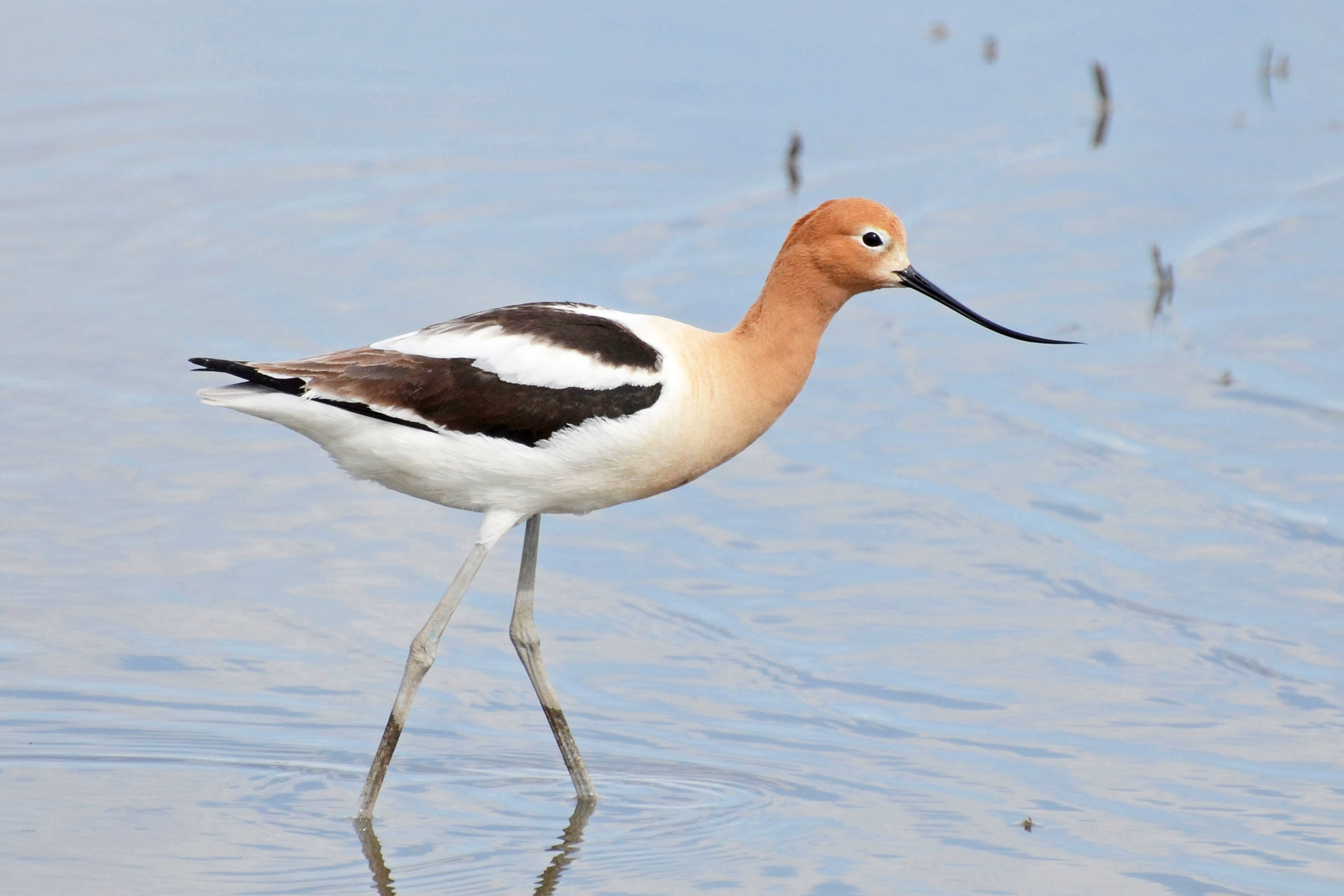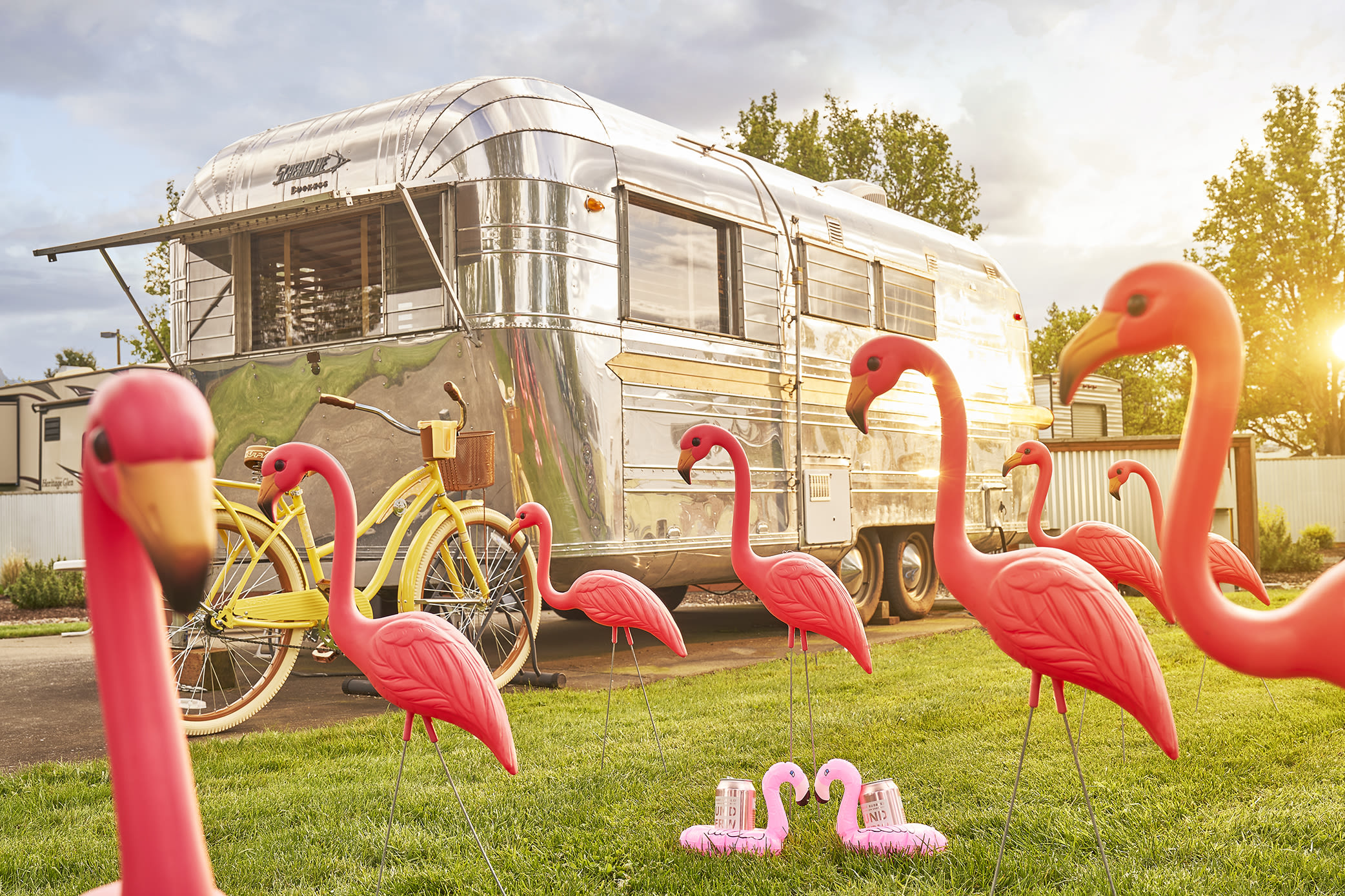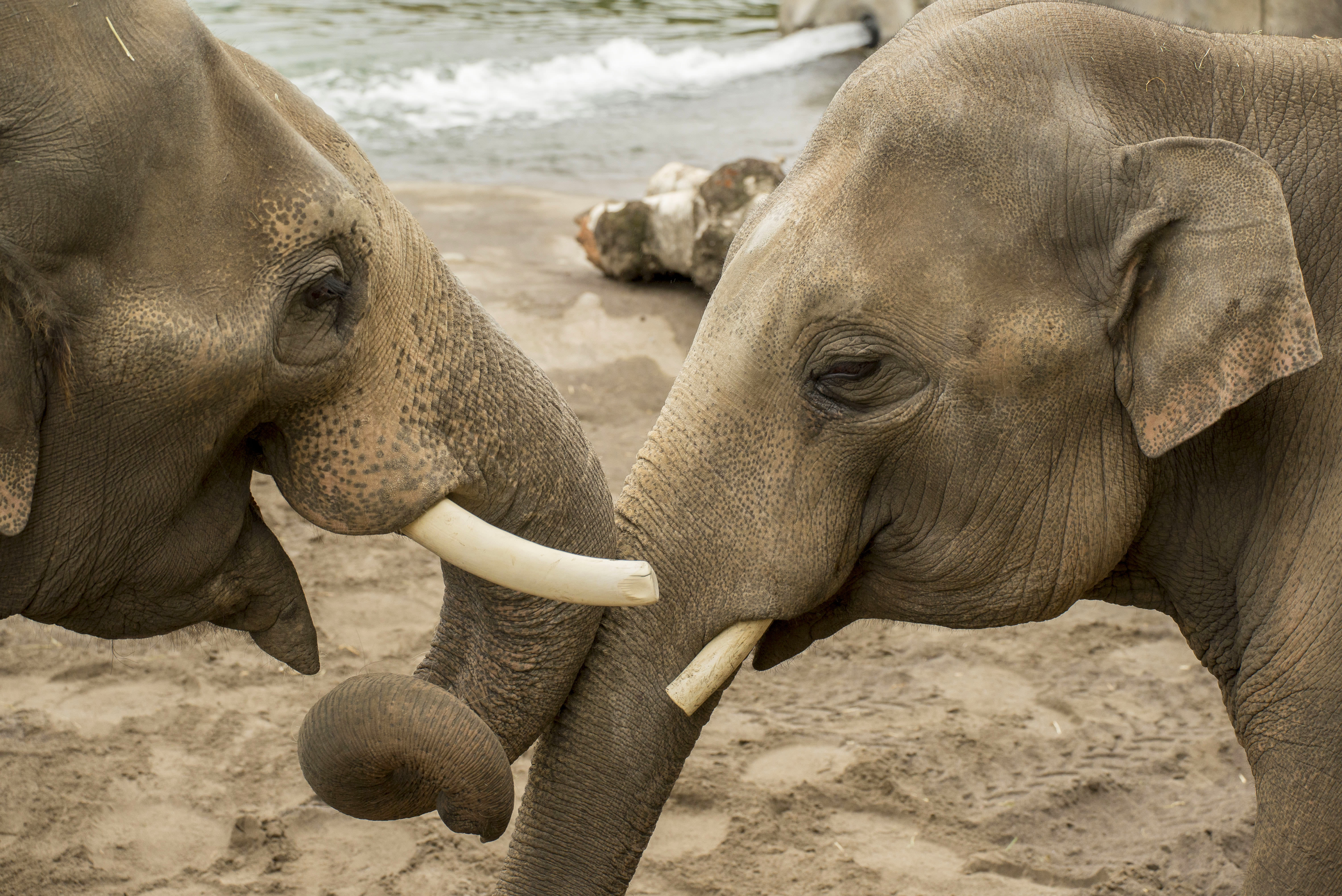
A Closer Look at the Oregon Zoo’s Elephant Breeding Program
On a cold December morning at the Oregon Zoo, three Asian elephants, known to walk more than a dozen miles each day in the wild, were outpaced by several small children running back and forth on the other side of the fence. The concrete path adjacent to the elephant exhibit featured several displays designed to teach visitors about the lumbering creatures in front of them. “They’re social and remember family and friends for a lifetime,” reads one. Another says: “A trunk’s touch can mean, ‘Settle down,’ or ‘I’m glad to see you.’” Face to face with the elephants, the kids seemed awed. At least for a few seconds. Then they were more interested in galloping on two sets of white, painted pachyderm footprints, one big, belonging to an adult, and one small—a calf’s.
During that late-fall visit, I overheard one of the zoo’s many patrons—a Portland mother with one eye on her own small child as she spoke—tell her visiting family that Lily, the youngest of the herd, had died a year earlier in 2018, succumbing to elephant endotheliotropic herpesvirus. Known as EEHV, it’s caused about half of the deaths of young elephants in zoos since it was first identified in 1995.
Over half a century, there have been 26 live elephant births at the Oregon Zoo, which touts its breeding program as an integral part of efforts to save the Asian elephant species amid land fragmentation and other woes back in their range countries. During that time, 19 elephants have also died at the zoo, including calves and elephants that were born elsewhere, plus two stillbirths.
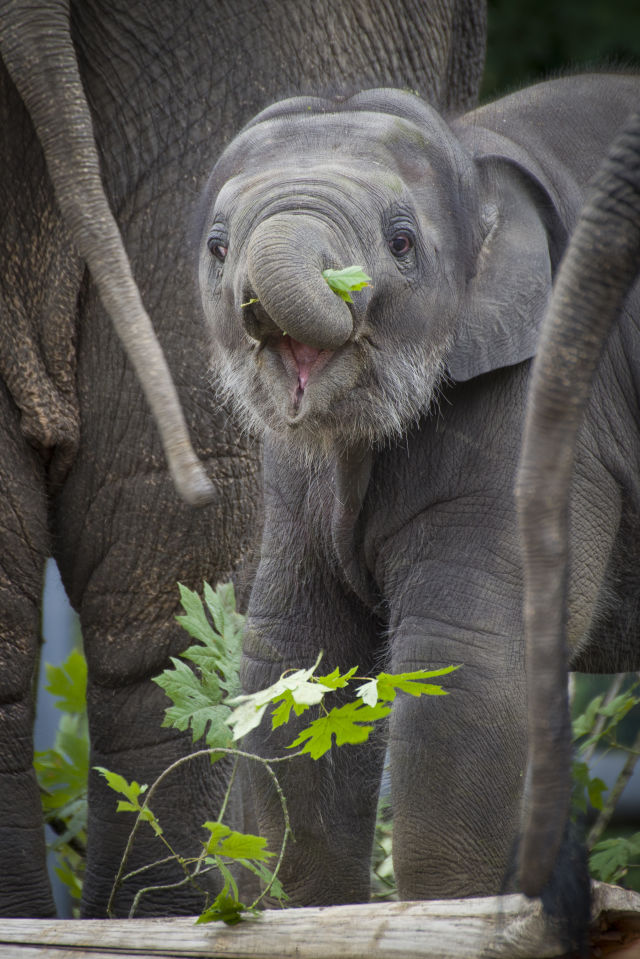
Asian elephant calf Lily in September 2013.
Image: Courtesy Oregon Zoo and Michael Durham
Lily, the daughter of another Oregon Zoo resident, Rose-Tu, was nearly 6 years old. Officials said she was with her mother when she died and that the zoo’s two other females, Shine and Chendra, also spent time by the ailing calf. As captive elephants across the United States age, Lily’s death was another blow to a zoo industry trying to infuse new life into its elderly population. Less than a third of Asian elephants in captivity can possibly reproduce—the rest are too old.
Soon, though, the zoo announced it was expecting another baby. Chendra was pregnant. And she was special: in North America, she is the lone Borneo pygmy, a subspecies of Asian elephants. The zoo had long hoped to breed Chendra; previous attempts had been unsuccessful. But officials seemed surprised by the discovery because, they said, no one saw her coupled with either of the zoo’s male elephants, Samudra and Samson.
The news, announced in summer 2019, was shadowed by early signs Chendra had tuberculosis. She was quarantined while veterinarians treated her. Elephants gestate for 18 to 22 months, but when Chendra was eight months pregnant, vets detected a drop in her reproductive hormones. By September, tests confirmed that she was experiencing a miscarriage, though the zoo said it was unrelated to the disease. A few weeks later, Chendra delivered the dead fetus.
For elephant welfare advocates who believe the animals are too intelligent, too compassionate, and too big to live in captivity, the miscarriage—so soon after Lily’s death—was fuel for a well-tended fire. For years they’ve been beating the drum: elephants suffer in zoos as their mental and physical health deteriorates, they’ve claimed, and it’s inhumane to breed more elephants doomed to exhibits.
“They need elephants to fill their cages to bring the people in,” says Alyne Fortgang, cofounder of the Seattle group Friends of Woodland Park Zoo Elephants. “It’s all about the money as far as I can see.”
Don Moore, director of the Oregon Zoo, calls such claims “incredibly naive.” Asian elephants are endangered. In the wild, only 15 percent of their original habitat remains. With the wild animals’ security compromised by the rapid encroachment of palm oil plantations and other human development, zoos argue their captive counterparts are invaluable. But as more elephants are bred and not bound for Asia, the din continues to grow. Who are zoos trying to save—the elephants, or themselves?
The Oregon Zoo’s first baby was unplanned.
When Belle arrived from Seattle's Woodland Park Zoo in 1960, keepers didn’t know she was pregnant. But when her calf was born on April 14, 1962, he drew international attention to the Rose City. Telegrams wound their way around the world and people waited in half-mile-long lines to see 225-pound Packy take his first wobbly steps. Life magazine devoted 11 pages to him. He was the first elephant born in an American zoo, and he was a moneymaker. Attendance tripled that year and the zoo topped a million visitors.
Since then, more than two dozen elephants have been born at the Oregon Zoo. But the fawning press in the decades following Packy’s birth has been supplanted by critical investigations into elephants’ welfare in American zoos as scientists better understand their behavior and sentience. A sweeping 2012 investigation in the Seattle Times looking at elephant fatalities at
accredited US zoos concluded that “the decades-long effort by zoos to preserve and protect elephants is failing, exacerbated by substandard conditions and denial of mounting scientific evidence that most elephants do not thrive in captivity.”
Breeding certainly seems compromised. At least a quarter of all Asian elephants live in captivity, and, according to a 2012 study published in scientific journal PLOS One, neither wild nor captive populations are sustainable based on fertility and calf mortality rates. In Portland, a historical elephant breeding powerhouse, only two Asian elephants have been born in the past 25 years. Captive elephants have a low birth rate compared to elephants in the wild overall, and, the Times reported, the infant mortality rate for elephants in zoos is nearly triple the rate in the wild.
“The only way we’re going to have a successful elephant program in the United States is if we’re successful at breeding them,” says Janine Brown, a reproductive physiologist at the Smithsonian Conservation Biology Institute. The Oregon Zoo has been at the forefront of that effort. It also helped establish protocols, she says, like hormone monitoring to track reproductive cycles. The zoo is one of only a few facilities worldwide to have an endocrine lab on site.
In fact, for most of the 20th century, Oregon was the only zoo in North America where Asian elephants born in captivity survived past their first birthday. Of the 28 Asian elephants born on the continent through 1980, 19 were born in Portland, according to the zoo. The other nine, born elsewhere, died in infancy.
At 27, Chendra’s childbearing window is closing. (Borneo pygmy elephants typically live for up to 60 years in the wild.) Bob Lee, the Oregon Zoo’s “elephant curator,” says he doesn’t expect she’ll conceive again. He regrets she will probably never have the chance to raise her own calf, an experience he describes as “one of the most enriching things in an elephant’s life.”
But not everyone thought this was such a bad thing. “I almost felt relief,” says Ann Radley, a volunteer for Free the Oregon Zoo Elephants. “It’s just a business—a breeding business.” Radley was skeptical having a baby would be healthy for Chendra and suspicious that she somehow mated without the zoo knowing, suggesting that perhaps, instead, she was artificially inseminated, a procedure some elephant advocates find so invasive they equate it to rape. Other detractors, meanwhile, were distraught keepers had allowed the relatively tiny Chendra to breed with one of its Asian males at least 3,000 pounds larger. Courtney Scott, president of FOZE, wants to know how mixing Chendra’s genes with those of an animal like Samudra does anything to save the Borneo elephant species. Besides, Scott says, “It’s not saving the species by breeding them and keeping them in a zoo. It’s a very stunted life."
In 2008, voters approved a $125 million bond measure activists thought would help fund the development of an off-site elephant preserve. By 2012, the zoo had set its sights on Roslyn Lake Park in Sandy. The former Portland General Electric storage reservoir was drained four years prior, leaving behind 240 acres of muddy grassland perfect for elephants to roam in a way they couldn’t in their comparatively confined zoo habitat.
But the refuge was scrapped after a feasibility study showed the project would require a costly endowment; FOZE criticized the zoo for mishandling that money. (The bond was used, in part, to renovate its elephant habitat.) “What began as an effort to create truly humane conditions for the elephants has now become a program to recklessly breed them,” reads a statement on the FOZE website. After Chendra’s miscarriage, the group renewed its call for the facility to relinquish its pachyderms to sanctuaries.
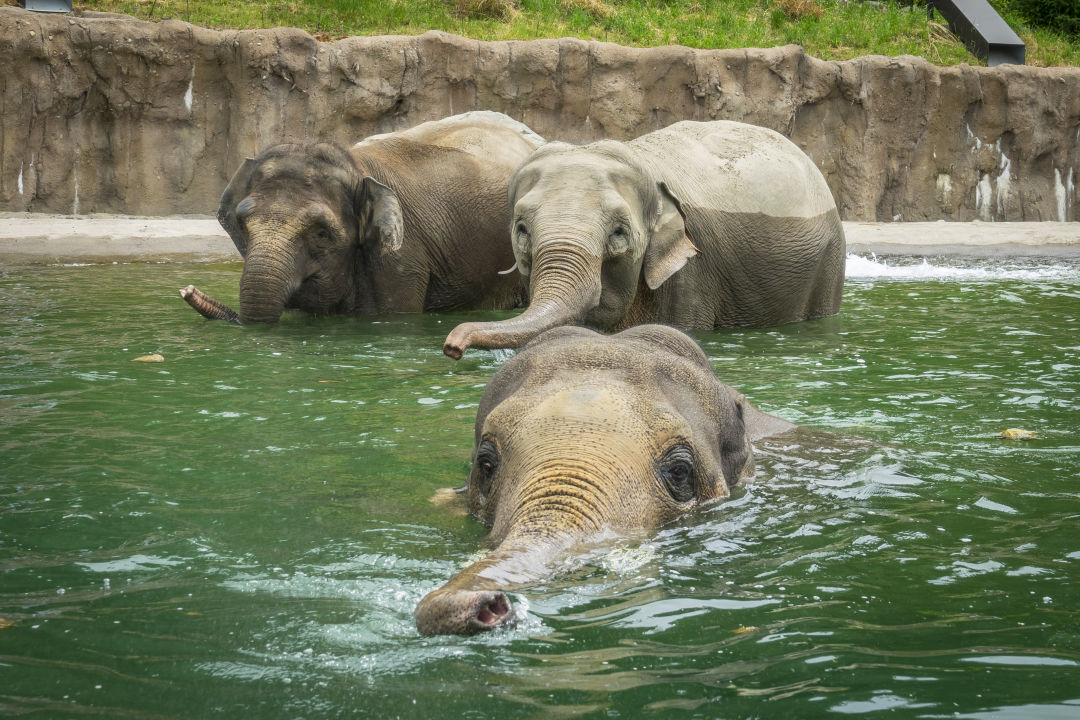
Chendra, Rose-Tu, and Samudra in the Elephant Lands pool.
Image: Courtesy Oregon Zoo and Kathy Street
In 2005, the Detroit Zoo, heeding concerns about its habitat’s limitations, shuttered its elephant exhibit, sending 53-year-old Winky and 47-year-old Wanda to the Performing Animal Welfare Society’s rolling, 2,300-acre sanctuary in California. The elephants had lived at the zoo for more than a decade. The zoo said in a statement that despite its best efforts “we saw the unfortunate results of them living in an unnatural physical and social environment.”
Even sanctuaries are extremely limiting for elephants, says PAWS president Ed Stewart. But zoos especially can’t match what animals have in the wild. No matter how much bigger or better a facility makes its elephant habitat, it’s already obsolete, he says. Breeding in captivity, he adds, means you’re producing elephants that will endure a deprived life. “When you see a wild elephant in a wild habitat, there are no fences,” he says, “there are no moats, there are no feeding stations. They are surviving in a perfect world. And unfortunately, the problem now is their perfect world is getting smaller and smaller, and breeding elephants in captivity is not going to change that.”
PAWS doesn’t breed the elephants that live at its sanctuary, putting it at odds with the Association of Zoos and Aquariums, which encourages captive breeding programs as part of its mission to save the Asian elephant species. The AZA, as it’s known, accredits zoos based on what it calls “the highest standards in animal care and welfare.” A page on the AZA-accredited Saint Louis Zoo’s website tries to educate visitors on “The Need to Breed,” explaining that because some scientists believe the Asian elephant could become extinct in the wild by the middle of the century, “captive management programs are becoming increasingly important to the survival of the species.”
In 2014, a story in Scientific American spotlighted the Oregon Zoo as one of a few zoos trying to use animal welfare science to make its elephant habitats bigger and more intellectually stimulating, like sanctuaries. But the author also said that such efforts were “at once an acknowledgment and dismissal of the research on elephant intelligence and welfare. After all, if the zoos
really have the animals’ best interests at heart, they would close their elephant exhibit.”
When I visited the Oregon Zoo, elephant curator Lee showed me around what’s now called Elephant Lands, home to the zoo’s current herd of four adult elephants and one growing bull. Circumventing the six-acre stretch where Lee says Chendra generally walks 10 miles a day, he pointed out a 160,000-gallon pool for the elephants to swim and four-foot-deep sand covering the ground to protect the elephants’ feet and joints. “Enrichment bags”—hay hung above the elephants’ heads—require them to reach to eat. More timed feeders scattered around the habitat are meant to encourage the animals to graze like they would in the wild.
Zoo director Moore calls these captive animals “insurance populations.” “We need to save the habitat, have an insurance population in zoos, and be able to reintroduce some later on,” Moore says, though he admits shoring up wild elephant herds with zoo animals is a “very, very long-term” plan. More immediately, he says he wants zoos to lead in global habitat conservation, provide quality animal welfare for the elephants that are in zoos, and educate the people who come to see them “so that we can continue to provide a better future for wildlife.”
Between more than 230 AZA-accredited institutions, Moore says, each is contributing about $1 million annually to field conservation. The Oregon Zoo helps the wildlife department in Chendra’s home country of Malaysia manage human-elephant conflict and pays for two wildlife rescue unit rangers and a truck to replant corridors between national park areas.
“I just don’t believe that we could engage and inspire the public to give to the Oregon Zoo Foundation at the level that they give without the elephants that are here,” he says. “Think about meeting an elephant, the largest land animal in Southeast Asia. It’s a pretty awe-inspiring experience.”
It can be hard not to project our human ideas and feelings onto these animals that are at once so alike and so different from us. Reading that Chendra’s pregnancy had ended prematurely reminded me of friends who have mourned their miscarriages. Learning she probably wouldn’t be able to get pregnant again stirred up my own anxieties about motherhood.
Dumbo, sensational news reports, and emerging science about elephants’ emotional capacity can transform these huge creatures with trunks into mirrors for ourselves. And it’s here that both proponents and critics of keeping elephants in zoos and captive breeding find points to argue their cause.
Gay Bradshaw, a psychologist, ecologist, and founder for the Kerulos Center for Nonviolence, which “supports animal rights and freedom,” likens zoo habitats to concentration camps. “They’re in anguish. They’re severely traumatized in body and mind.”
Bradshaw and FOZE, which has been urging the Oregon Zoo to free Chendra since 2015, are among the activists who believe elephants would generally be better off in sanctuaries. But it’s not quite that simple, at least according to the zoo. “Freeing” animals could mean placing their lives in danger, Moore says. Chendra—who was orphaned as a 2-year-old calf after a conflict with humans near a palm oil plantation in Sabah, Malaysia—has at times seemed to favor her keepers to other animals. She was shot back in Malaysia, causing permanent blindness in her left eye. Wildlife officials decided she couldn’t survive in the wild, and she was relocated to the zoo, a five-day journey through Kuala Lumpur, Seoul, Alaska, and San Francisco before she landed in Portland in 1999. Removing her now to live at a sanctuary would sever the bonds she’s made with both the zoo’s other elephants and employees over the past 20 years, Lee says.
There’s growing evidence of elephants’ intelligence, especially as scientists better understand how they interact with the world. Elephants are special, says Joshua Plotnik, a psychology professor at Hunter College who studies animal behavior, cognition, and conservation and founded Think Elephants International, an organization that advocates for conservation by involving kids in the study of elephant behavior. Unlike most species, he says, elephants can recognize themselves in the mirror, an ability he thinks is linked to their capacity for self-awareness and empathy. Studying Asian elephants at the Elephant Nature Park in Thailand about 13 years ago, he saw them rushing to other elephants squealing or trumpeting in distress. They mourn their dead, circling the corpse and gently prodding it with their trunks.
They’re also incredibly social and form tight-knit, matriarchal herds highly protective of their young. In October, media reported that about a dozen elephants tumbled to their deaths at an elephant facility in Northern Thailand. Photos from the scene showed lifeless lumps of gray emerging from the churning river below. Plotnik spoke to several elephant research colleagues in Thailand after the incident, and though no one witnessed what happened, he says the elephants were possibly forced over a slippery surface by fast-moving water in heavy rains—a flash flood. But another narrative has prevailed in the public’s mind: a calf slipped on the waterfall, and one by one, the other elephants went over the edge trying to save it.
About four years before she HAD Lily, Rose-Tu gave birth to her first calf, Samudra, in 2008. It was the Oregon Zoo’s first birth since Rose’s own delivery 14 years prior. The zoo said it planned to keep Shine and Chendra in the elephant barn in hopes she would have support during the process. But the birth didn’t go as planned. When the baby emerged in August, Rose-Tu tried to trample him. Keepers hurried to separate mother and calf. (They were later reintroduced and eventually bonded.) Zoo officials said Rose-Tu’s reaction was due to inexperience; she had never witnessed a birth before. They said she was scared.
Others think infanticide is a symptom of a bigger problem: captivity. “The simple answer is this is psychological trauma,” Bradshaw says, “severe trauma.” Some have even speculated that elephants kill their young to save them from a life in captivity.
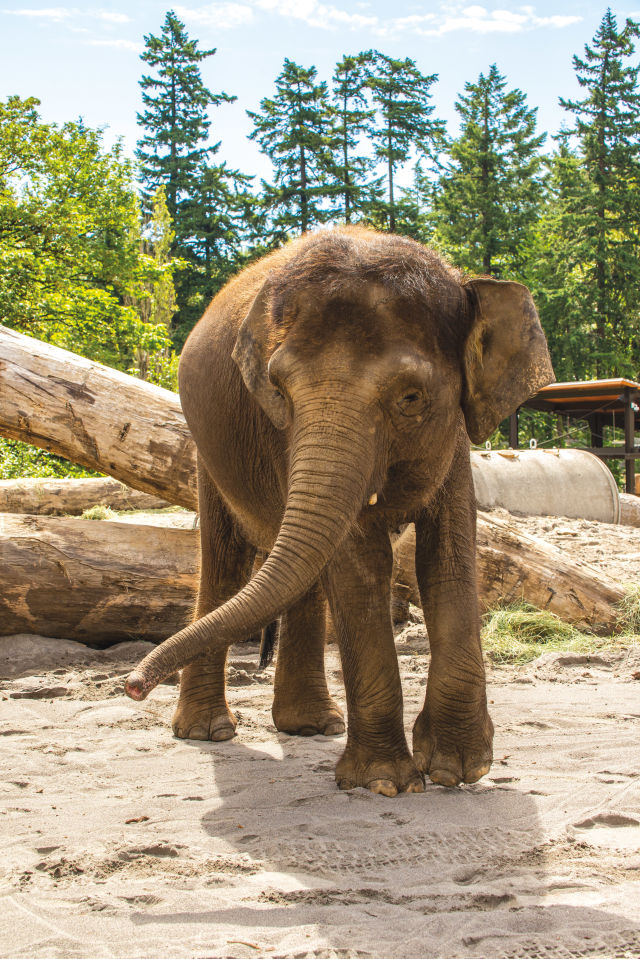
Chendra, the Oregon Zoo’s Borneo pygmy elephant, in the zoo’s Elephant Lands.
Image: Courtesy Oregon Zoo and Michael Durham
Plotnik disagrees. Rather, he says it sounds like more anthropomorphizing as humans project their own emotions on elephants about keeping them in captivity. While infanticide and suicide exist in the animal kingdom, scientists don’t know of any species that purposefully kill their young because of their circumstance, he says. “What’s very dangerous about sentiments like that is it takes away from what really needs to happen, which is to improve the quality of welfare that elephants in captivity generally need.”
Zoos, Plotnik says, are at a difficult crossroads in trying to justify their existence. They must demonstrate that the opportunity for the public to see an endangered animal up close will both lead to raising more money to help these animals in the wild and inspire people to take other measures to protect them.
Other elephant advocates, some of whom are burned out after years of pushing against zoos, say that confining elephants in zoos will someday be remembered as, in Bradshaw’s words, a “dark part of our history.” Someday, they hope, is soon.

